|
|
Single-deck centenary run
12 November 2012
Page last updated 21 February
2013
In the 19th century, London’s horse bus proprietors soon
discovered the benefits of carrying passengers ‘on top’, with much
of the impetus credited to the Great Exhibition of 1851. With
competition from the trams, the improved economics led to the
double-deck bus becoming the standard design. For the LGOC, if not
elsewhere, this was carried through into the motor bus era and all
early designs were double-deckers. It remained LGOC and
London Transport policy to use double-deck buses wherever
possible, until the dramatic changes in the 1960s.
London's first single-deck motor bus route (as distinct from
routes in the country around London) was route 69 through Blackwall
Tunnel, introduced on 12 November 1912. It was soon
renumbered 108 and later split to form the 108 and 208. To
mark the centenary, RF486 and RTL453 ran over the routes on
Monday 12 November 2012. This page tells the story; see also
the photo gallery.
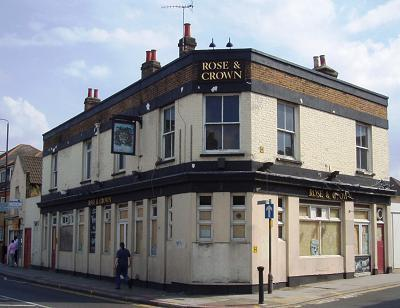
The Rose & Crown, Plumstead,
after it closed, but before rebuilding.
Photo © Ewan Munro.
Route 69
New route 69 ran from Plumstead Orchard Road, Rose &
Crown, via Woolwich and Tunnel Avenue to Poplar Blackwall
Tunnel. It was operated by single-deck motor buses
and replaced a Tilling horse bus route through the tunnel,
which had opened in 1897. The Metropolitan Police were
not prepared to allow double-deck buses in the tunnel, so
a single-deck version of the B-type was developed.
The route lasted only seven months in this form, as in the
meantime, new route 53 had been introduced from Plumstead to
central London along the same route as far as Woolwich Road, and
the 69 was shortened in June 1913 to run from the Ship & Billet
to Poplar. The 53 from central London still
terminates at Plumstead Orchard Road, although it now runs
into the new Plumstead garage to lay over.
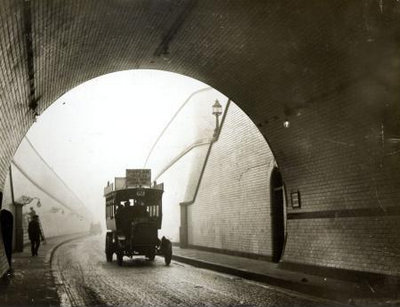
A B-type on route 69 enters the southern
entrance of the Blackwall Tunnel.
Photo © London Transport Museum
Route 108
Nine months later (29 Mar 14, four months before the outbreak of
war), route 69 was extended at both ends and renumbered 108 -
full history here and here. The new 108 ran from Bow to
Blackheath, but this was short-lived, as the outbreak of war led to
changed priorities and the route was shortened back to that covered
by the 69.
It was 1922 before the route was extended again, this time to
Clapton Pond in the north and Lee Green in the south, via Homerton,
Hackney Wick, Old Ford, Bromley by Bow, Poplar, East Greenwich
and Blackheath. The full route ran as 108A.,
with the Poplar Blackwall Tunnel to Greenwich
Ship & Billet route still numbered 108. The
following year, the 108A beyond Blackheath was changed
to run to Lewisham, and then Forest Hill.
The 108 was operated by Athol Street garage, Poplar (C), but
when it was extended in 1922, their B-types were joined by new
S-type single-deckers from Dalston garage (D). By 1924, the
Bs from Athol Street had been all been replaced by Ss.

It is November 1923, and new
S882 is running the 108 - at the time the short version
of the route, between
Woolwich Road and Poplar. It is operated by Athol Street
garage (C). Photo ©
London Transport Museum
Route 108C
In 1924, when the new Metropolitan Police numbering regime was introduced under
Chief Constable Bassom, the Clapton Pond to Forest Hill route
(being the longest extent of various workings) was renumbered
108. As usual under the Bassom system, the public was to be
confused by a range of short workings, using suffix letters, which
changed at least four times over the next 10 years.
One of these changes took place when the Wick Lane canal bridge
was closed in 1926-27, and the route was split to run
108C Clapton Pond to Victoria Park Wick Lane
Canal Bridge and 108D Victoria Park Wick Lane
Canal Bridge to Forest Hill Station. When these
numbers were no longer needed, 108C became a short
working from Clapton Pond to Poplar Blackwall Tunnel,
used when the tunnel was closed for a few months.
The next and most important change came immediately
afterwards, again courtesy of the Metropolitan Police. The
108 was heavily used through the tunnel and discussions commenced
with the police regarding double-deck operation. These led in
1927 to the prototype 'tunnel' NS, lower than usual and with a
specially curved roof and curved enclosed rear end. NS2050,
which ran alongside the Ss over that summer, was a success and led
to the construction of 24 similar buses.
But the NSs could not run under the low bridges in Bow or
Hackney Wick, so the route was split on 19 October 1927, whence we
have two histories – the single-deck 108D from Clapton
Pond to Bromley by Bow and the double-deck 108B from
Bromley by Bow to Forest Hill. The 108C was now a
short working of the 108B, running from Greenwich
Tunnel Avenue to Bromley by Bow; the 108 through route no
longer operated.
Route 108D
The 108D continued between Clapton Pond and Bromley
by Bow, operated by Dalston with Ss and (from 1930) Ks, then in
1931 both were replaced by new LT Scooters.
In 1934, the service ran every 5 minutes during the week, 3½
minutes on Saturdays and 4 minutes on Sundays. Whilst the
1927 bus map showed the 108D separate from the
108B, by 1933 this distinction had been dropped and the
whole route was described only as '108'. Timetables did not
show route suffixes, so it was only by careful study of first and
last times that it became clear that there was no through running,
but each bus met its counterpart at Bromley by Bow, where they
arrived together, waited 3 minutes then left together. No
mention is made in the timetables of through fares until 1936,
probably because of restrictions on space rather than not being
offered.
In the 1934 renumbering, the
108D became the 208.
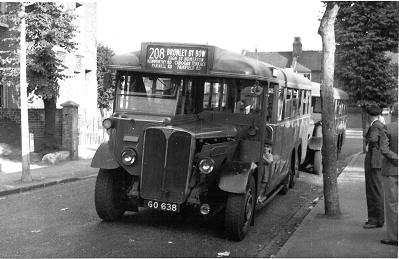
Route 208
The route was becoming ever busier – especially on
Saturdays. In 1936, the 208 was the first route on which the
new 37-seat Qs were introduced, working jointly with Scooters on
the route until the introduction of RFs in 1952/3.
As usual, Scooter LT1031 is
overheating (or at least overheating the driver) and the bonnet
side is open. The scene is Clapton Pond in 1949.
Photo © Alan Cross
Following the introduction of RFs to sister weekday route
208A in October 1952, the new
buses made weekend appearances on the 208. The route was the
last to operate Scooters, albeit as unscheduled replacements, and
in January 1953, two new RFs were delivered in advance of the
remainder of the 208 allocation to enable the last Scooters to be
retired on 31 January. The remainder of the RF allocation
arrived the following month, replacing the Qs.

The first RF delivered for
the 208A in October 1952, RF303 is already looking
rather battered by life in the East End whilst still relatively
new. It is on route 208 at Clapton Pond.
Photo © Alan Cross
The 208 lasted as long as the crew-operated RFs, being replaced
by new buses on new route S2 in April 1970.
Route 108B
Back in 1927, delivery of the new tunnel NSs to Athol
Street garage was completed in December, from when the route
through the tunnel was double-deck operated until one-man Merlins
arrived in 1970.
The 108B switched its southern destination in 1930
from Forest Hill to Crystal Palace, so the route ran from Bromley
by Bow Seven Stars via Poplar, Blackwall Tunnel, East
Greenwich, Blackheath, Lewisham, Catford and Sydenham.
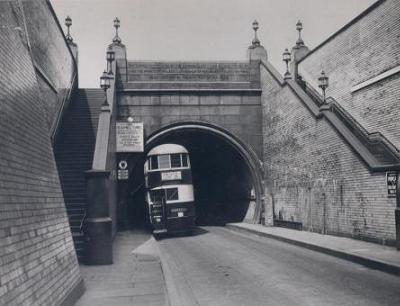
A tunnel NS entering the southern entrance
of the Blackwall Tunnel.
Photo © London Transport Museum
Route 108
In the renumbering in 1934, the route became the plain 108, and
three years later, the 10-year old NSs were withdrawn and replaced
by specially-built tunnel STLs.
These continued to be required until the police relented in
1951, permitting standard buses, although these still carried
strengthened tyres because of the constant rubbing against the
kerb. On the LT Museum site, a former Poplar driver recalls
how the tyres were used to full effect: 'We were equipped with
special tyres which had a wall indicator pattern round the wall of
the tyre. When the pattern wore down (when the indentations wore
almost smooth) the tyre was turned round. When BOTH walls
were worn the tyre would be fitted to the offside wheels, as the
tread would still be in good condition.'
Ian Smith
reports that the 108 route number became so well associated with
the Blackwall Tunnel in local folklore that there was a saying
"Watch out, here comes a 108" if someone yawned widely!
Standard STLs operated briefly, before being replaced by
RTLs during 1953, still working from Athol Street garage and
again with strengthened tyres. These continued to work the
108 and 108A until the garage closed in 1961, when the
operation moved down the road to Poplar garage (PR) - which had put
the first Routemasters to work when converted from
a trolleybus depot in 1959.
Following the opening of the new southbound tunnel in 1967, the
old tunnel was closed for the raising of the roadway to provide a
wider carriageway, thus removing for ever double-deckers from the
old tunnel, and doing away with the requirement for strengthened
tyres. The RTLs themselves lasted until 6 Sep 68, when the
Reshaping Plan swept away RTLs from east
London. They were replaced briefly on the 108/A by
RTs, but with re-opening of the rebuilt tunnel for northbound
working due in spring 1969, the 108 was equipped with new
one-man operated Merlin single-deckers (and the 108A
withdrawn from north of the river) from 26 Oct 68. Route
108 has been single-deck operated ever since; for more recent
history, see the London Bus Routes
site.
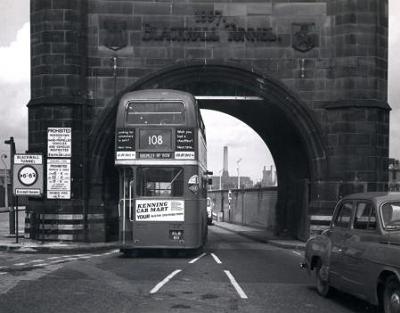
RTL424 passes under the southern gateway to the
tunnel, which still spans the northbound road, in May 1967, three
months before the southbound tunnel opened. The mix of old
and new traffic signs has now been replaced and double-deckers
can no longer use the one-way northbound tunnel.
Photo © London Transport Museum
|
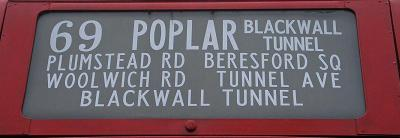
The B-types carried boards, not blinds, but
this is how a later blind might have looked.
Photo © Graham Smith
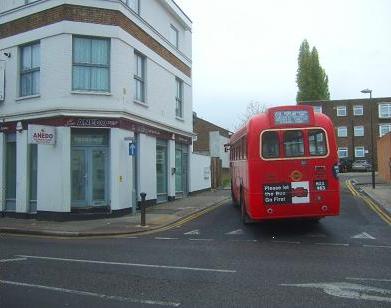
RF486 turns into Orchard Road past the former
Rose & Crown, to take up service on
route 69. Photo © Peter Osborn
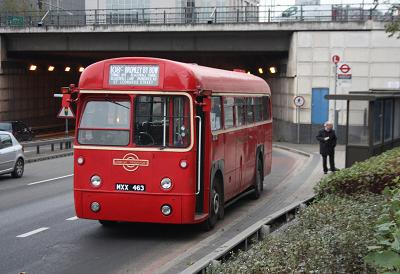
RF486 at Poplar masquerades
as a 108C, the October 1927 version between
Woolwich Road and Bromley by
Bow. On splitting the route into the 108B and
108D,
not all the tunnel NSs had
been delivered, so the 108B (and its short workings)
were
operated by both Ss and
NSs for the first few weeks. Photo © John Parkin
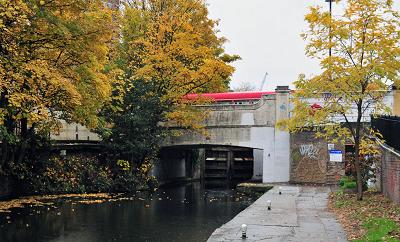
Wick Lane canal bridge, at
the southern end of Victoria Park.
Photo © Steve Whitelegg

From the extension of the 108 to Clapton Pond
in 1922 until the replacement of the
208 by the S2 in 1970, the route ran alongside
Victoria Park via Cadogan Terrace.
RF486 is seen on the road, which last saw
buses at the Hackney Marshes running
day
in 2006. Photo © Steve Whitelegg
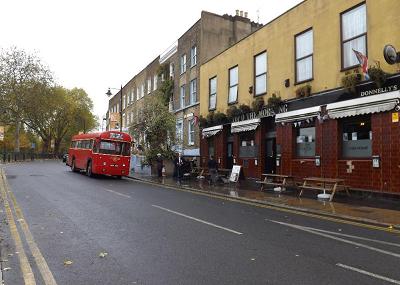
Cadogan Terrace, and RF486
returns to Bromley by Bow as a 208. The Victorian
pub was previously called the
Mitford Castle and carries a plaque in remembrance
of a murder victim in 1864,
thrown from a train onto the line behind the pub and
tended by the landlord before
he died. After our run, this story was televised as
Murder on the Victorian
Railway. Photo © Daniel Sullivan
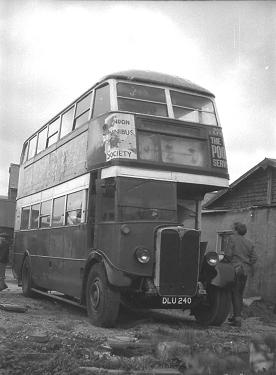
Sadly no tunnel STLs survive;
although STL1871 did make it into preservation (and
is seen here on a LOTS trip
in the mid-60s), its condition was (sadly, and perhaps
prematurely) considered too
bad to rescue and it was scrapped in 1967.
Photo © Peter Osborn
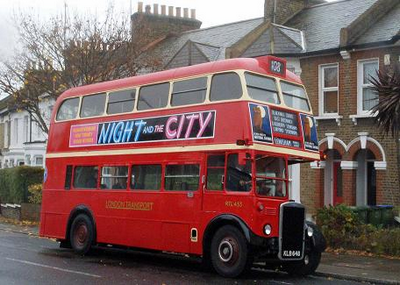
RTL453 was one of the RTLs that lasted
almost to the end in autumn 1968, and was
LT's last roofbox RTL when withdrawn at
Cricklewood. Here running over the 108
from Bromley by Bow to Lewisham on 12 Nov 2012,
it is seen in Westcombe Hill.
Photo © Graham Smith
|